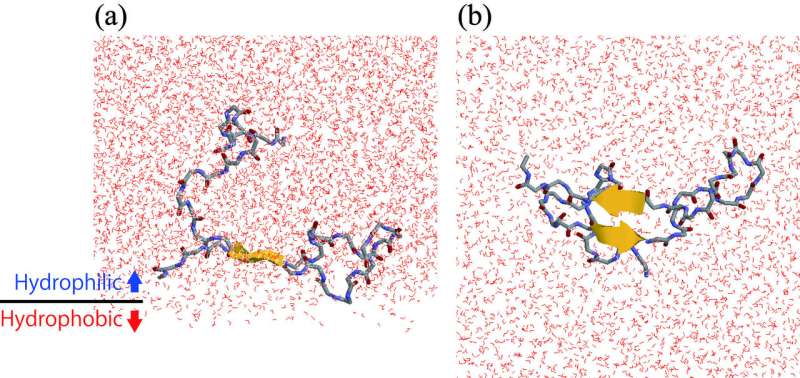A boundary dance of amyloid-β stepping into dementia

Alzheimer's disease is caused by aggregates of amyloid-β (Aβ) peptides. This aggregation is accelerated at the cell membrane surface. Using molecular dynamics simulations and NMR experiments, the research group at ExCELLS has revealed the reason for this phenomenon. The findings were published in the Journal of Physical Chemistry B.
Many proteins aggregate at higher concentrations and form spherical substances called oligomers and acicular substances called amyloid fibrils. These protein aggregates cause more than 30 kinds of disease. For example, Alzheimer's disease is thought to be caused by the oligomers and amyloid fibrils formed by aggregation of amyloid-β (Aβ) peptides. It is known that aggregation of Aβ peptide is accelerated at a hydrophilic/hydrophobic interface such as a cell membrane surface. However, why the Aβ peptides tend to aggregate on the surface has not yet been well understood.
The research group at Exploratory Research Center on Life and Living Systems and Institute for Molecular Science, Japan, worked on this problem using molecular dynamics simulations and nuclear magnetic resonance spectroscopy experiments. They found that the Aβ peptides tend to gather at the hydrophilic/hydrophobic interface. That is, the local concentration of Aβ at the interface is higher than that in bulk water solution. In addition, β-hairpin structures are formed more at the interface than in the bulk water solution. In the β-hairpin structure, as shown in the figure, a part of the Aβ peptide extends straight and forms intramolecular hydrogen bonds. Therefore, another Aβ peptide that comes close to this peptide easily makes intermolecular hydrogen bonds and tends to aggregate. In this way, the research group clarified that aggregation acceleration of the Aβ peptides on the cell membrane surface is due to high concentration of Aβ peptides on the cell membrane surface, and their structure, by which they bind to each other.
This discovery elucidates the mechanism by which the Aβ peptide aggregates on the membrane surface of nerve cells. This mechanism could be applied to developing inhibitors against the causative substances of Alzheimer's disease in the future.
More information: Satoru G. Itoh et al, Effects of a Hydrophilic/Hydrophobic Interface on Amyloid-β Peptides Studied by Molecular Dynamics Simulations and NMR Experiments, The Journal of Physical Chemistry B (2018). DOI: 10.1021/acs.jpcb.8b11609
Journal information: Journal of Physical Chemistry B
Provided by National Institutes of Natural Sciences





















